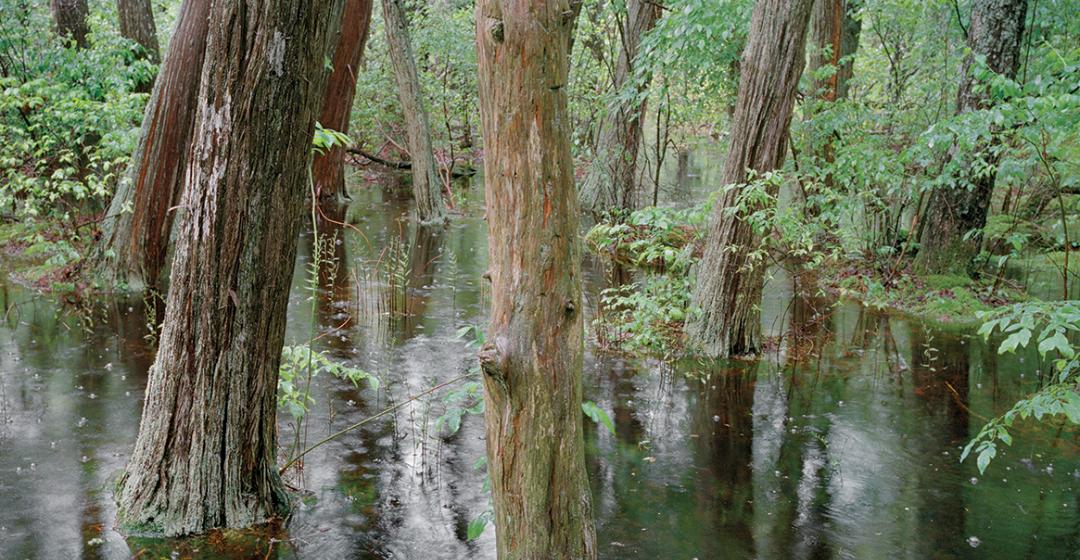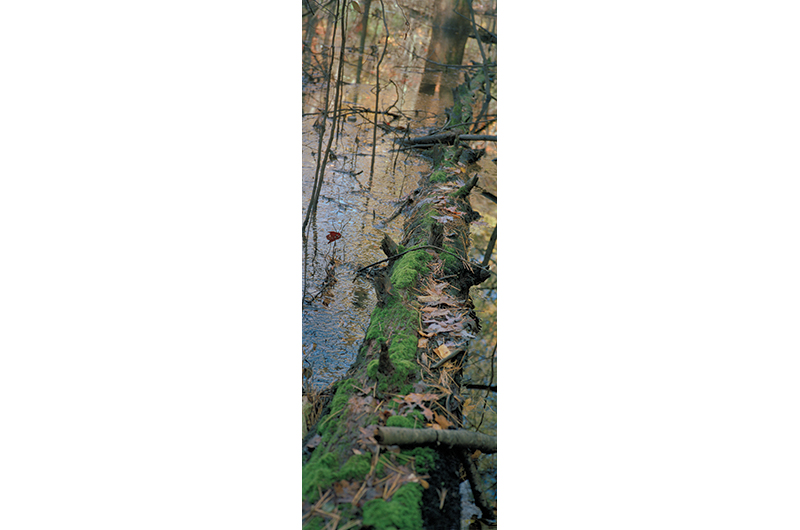It turns out New England swamps are infinitely more interesting and dynamic than those in the South. Too much of the same-old, same-old down there, says photographer Barbara “Bobbie” Norfleet. And too many people admiring the muck from boardwalks facilitating public access.
For ninety-two-year-old Norfleet, whose life changed when she took a photography course at forty-five and whose work is in the permanent collections of some of the most prestigious museums in the country, New England swamps had it all:
individuality, quiet, and challenge. Her “Swamp” series is showing at the Sargent Gallery in Aquinnah, with an opening on August 5, from six to eight.
The project was inspired by a book on swamps published in England that featured mostly paintings, but there were two photographs, including an early swamp image by Norfleet. “I thought it was gorgeous and that as soon as I retired, I was going to do it,” she says. Beginning in earnest in 2005, she expected to shoot mostly in the South, but quickly returned home to New England where she has lived, worked, and raised a family. “In New England, I felt often like I was the first person to go there, and the silence – hearing the birds and insects and nothing else – was part of the experience,” she recalls.
Using topographical maps, she and her trusty Hasselblad panoramic camera waded deep in the woodlands. “I went on my own, but as I got into my nineties I thought this is really too much,” she says. “It turned out I just adored doing it, and I hated giving it up because I wanted to see all the swamps. But the roads tend to avoid them and it’s a lot of brambles, fallen trees, and poles, and I felt it was just too dangerous to continue. I ended it when I decided my legs were no good mucking around in the wilderness all by myself.”
One of only three women to graduate from Harvard University with a Ph.D. in 1951, Norfleet taught social science there for a decade before taking the next decade off for family life. It was during this period that she and her late husband discovered the Vineyard, coming first in 1955 and soon thereafter building a house on Tisbury Great Pond. “I mean, we literally built our own house. My husband and three boys, we did every bit of it, even the foundation. We didn’t have electricity for the longest time, no phone, but my kids loved it. And in our area there were people sailing on the pond or on the beach, and we’d invite them back for drinks, not cocktails, and suppers, not dinners. It was all very simple back then,” she recalls.
When she returned to professional life at Harvard, that photography course beckoned “and suddenly I realized my whole life was a mistake,” she says with a chuckle. What she went on to do was to challenge the focus on the formal aspects of photography, which at the time was all about dark and light and verticals and diagonals – what was inside the photograph. “I felt everything was actually outside the picture,” she says.
In the early seventies, she became the curator of photography at Harvard’s Carpenter Center for the Visual Arts. But with no budget to buy art photography, she turned to boxes of negatives she rescued from the professional studios that were in their prime across the country from the 1930s through the 1960s, a period when many people still weren’t taking their own family photographs. It proved to be a treasure trove that led to five or six curated books.
“These studio photographers needed to please their clients,” Norfleet explains, “so their photographs showed the values and attitudes of the times, whereas the art photographer was really expressing his own ideas. These pictures had very different information and they created quite a sensation.” The first book sold out, leading to two more reprints. Ultimately six books of Norfleet’s own photography were published and thirteen others include her images or writing. Examples of her work are in many permanent collections, including the Museum of Fine Arts in Boston and the Museum of Modern Art in New York.
Art wasn’t her only pursuit. With a group of other Harvard women, she broke the men-only barrier at the Harvard Faculty Club and produced a report on how poorly women fared at Harvard, which led to a large, formal committee. “We were the troublemakers,” she says.
Norfleet still returns when she can to a small house on North Road in Chilmark, while the original house on Tisbury Great Pond is filled with her sons’ families every summer. But these days rather than returning in the fall to Cambridge, where she lived for decades, she’s in an assisted living facility in Lexington. Still, there is always a project. Partly as a joke, she’s intrigued by what she calls “Giving Up.” For Norfleet, that’s all the things one gives up in one’s nineties – bikinis, martinis, high heels.
“I have all these pictures in my mind,” she says, “but I found the iPhone wasn’t flexible enough, so I bought this little digital camera and now I’m trying to figure out how it works.
“I’ve had my fame,” she reflects, “and I know I want to keep working because I want to keep working.”






